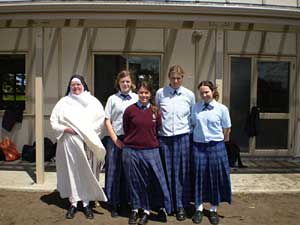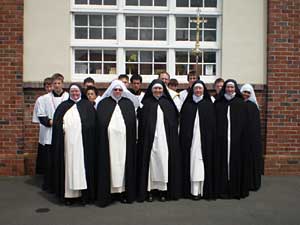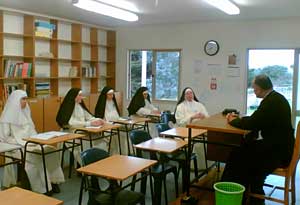

![]()
![]()
|
Newsletter of the District of Asia Jan - April 2007 The
Dominican Sisters First, God gave Sister Micaela, the foundress and actual Superior, a number of useful experiences. She began by entering the Sisters of Mercy in Wellington in 1966. It seemed a natural thing to do as she had been educated by them, but the fit was not good and she left. However, she had seen both the strengths and weaknesses of what was really still pre-Vatican II religious life. This was to be useful later on. God then sent Sister back to working for the New Zealand Government and eventually she returned to full-time studies at Victoria University for a Master’s degree in English. She then attended Christchurch Teachers’ College for one year and gained a Diploma in Teaching. Here, too, God’s providence was shown as she attended both these institutions before modernism and feminism had quite taken them over.
Mother Micaela with some of her students
SSPX Asia Newsletter Jan -Apr 2007 OP Sisters Having graduated from Teachers’ College, Sister Micaela traveled South to Dunedin and joined the novitiate of the Dominican Sisters of New Zealand. For her it was like coming home! The Dominicans were intellectual yet humble, humorous yet deeply serious about their apostolate, and they sang the Divine Office in the manner of angels. The Novice-mistress was also deeply Dominican and very sensible. Dunedin was well behind the times, being so far South, and this was a good thing religiously as Sister learned many good and useful things about religious life and had a reasonable formation. She also began teaching in a fairly conservative environment. However, even in Dunedin, which is fifteen years behind the rest of the country, the spectre of Vatican II was moving closer. Some changes had already taken place before Sister Micaela entered, such as using an English translation of the Dominican Breviary, but they were operating in such a conservative environment that they raised no alarm in her. Also, she was so pleased to have found a Congregation wonderfully different from what she had seen before that she was not as alert as she should have been to the danger of change. And as teaching takes a lot of mastering, her attention went on that, while she dismissed those who agitated for change as a bunch of mavericks. However, about 1980 Sister became more alert to the dangers of relaxing the discipline of religious life. She was still inclined to trust her superiors, a mistake at that moment! But she was definitely becoming alarmed and stating her conservative views more strongly, which led to a lot of ill treatment and punishment. Unfortunately things became more and more wrong. A sad discovery for Sister was the fact that the Prioress General was involved in the move for change, not a bulwark against disintegration, as she should have been. Sister Micaela was punished for her conservative views in various ways including being ordered to live outside the community. She obeyed but appealed to Rome against what was clearly an illegal command. Rome agreed with her and directed that she be received back into the community. However, in the judgment, Rome used the phrase, “if she continues to cause trouble”. All of a sudden Sister understood that Rome itself, i.e., the Sacred Congregation for Religious and the Holy Father himself, were on the side of the modernists. By this time she had few illusions left, which was, no doubt part of God’s plan. After all, we are told not to put our faith in chariots or horses but only in the name of the Lord! Sister was specifically told that as a punishment for appealing to Rome she would have to live with the General Council and study at Holy Cross Seminary, Mosgiel. She used the occasion to finish her Bachelor of Theology degree but was horrified by what was going on at the Seminary. Thus, further learning took place. She learned that theology and Scripture studies were rotten clean through, that the Church was rotten from top to bottom, and that you can live in almost any situation if you put your mind to it!
The Community with the new Novice
Being penniless she got a job in a State College and taught for a year. She had by this time made contact with the Conventual Dominican Sisters of Wagga Wagga in Australia and went to stay with them. Although her vision did not mesh with theirs it was valuable time for her as the three professed Sisters in Wagga Wagga were older than she and remembered more about traditional Dominican life. Although the Wagga Sisters were only conservative they taught Sister Micaela that it is easier to live the whole “package” of religious life rather than a few scraps. She also got a wonderful insight into the pitfalls of founding a new group and a view of the very interesting conservative scene. She realized, with sadness, that more was needed than conservatism. On returning to New Zealand she helped homeschoolers and discovered the Traditional Mass. One day she woke up with the conviction that the Society of St Pius X was not schismatic as she had been told. She approached a Mass Centre cautiously but soon spoke to Fr. Gentili and asked if she could be any help as a teacher. He invited her to Wanganui to teach as he had been looking for a nun to start a high school. It seems that God plans out very well the timetables of our deliverance from the wreckage of the modern Church. Sister Micaela had learned a lot in modern circles and in conservative circles. Now He put her on another learning curve in Tradition. First she taught two years in the primary school before she could start the secondary school, which gave her a good view of the traditional community and the traditional children. Then the experience of housing was an excellent lesson on coping with what the parish could afford. She began living in a flat, which the parish could not really afford, so then she moved to a little apartment made of one third of a classroom, with a wall not up to the roof, and a little kitchen and access to the disabled toilet and shower that schools are required by law to have. The next prior had a little more money and moved her into a small house.
The
new Girls' School just finished last February Her greatest difficulty at this time was living alone but she tried to adapt to it and to face the fact that there was, maybe, a lifetime of aloneness ahead of her. Through the Society of St Pius X, Sister had become acquainted with the Teaching Dominicans of Fanjeaux and visited them in France and America. She was hoping with their help to support her life as a lone Dominican Sister, when there was a change. The Fanjeaux Dominicans had a potential postulant helping in one of their schools, from a distant country, Australia, and they had just instituted a policy of not taking postulants from places far away. So they suggested to their aspirant that she come and join Sister Micaela. The future Sister Mary Madeleine did so, and another girl from Australia heard about the experiment and came too, though she did not stay permanently. They got permission from Bishop Fellay to have a community as an experiment for a year. After this he set them up as the equivalent of a Congregation of Diocesan Right. Since then other postulants have come and some have stayed and some have gone. At the moment there are six sisters, four professed and two novices. Sister Micaela moved again, when the first postulants came, to a large house that has been adapted over the years to the increasing numbers in the community. Now they have expanded beyond their house and the parish is building them a combined girls’ school and convent on vacant land behind the Church. This is an attractive building with classrooms on the ground floor and cells above it. Stage One is now completed and the Sisters have already moved into the building as of the beginning of February 2007. Space is extremely short in the new building but being close to their classrooms and the girls’ playground means a lot to the Sisters. They do look forward to the completion of Stage Two though, which will give them a convent of their own, with a community room, kitchen, refectory, laundry and chapter room. Stage Three, including a larger chapel, is being left until numbers have increased further. The outlook for the future is bright. The Sisters who have persevered in the Congregation are, according to Sister Micaela, good nuns. Some are studying for their degrees or for teaching qualifications. All, except the novices, take part in the teaching apostolate and make an excellent contribution to the school. The little Congregation is well looked-after by the priests of the SSPX, and the Teaching Dominicans of Fanjeaux continue their kind help. Indeed two of the Sisters have visited Fanjeaux, Avrillé, and Post Falls, Idaho in January 2007. They have learned more about the chant and the Office, the techniques of teaching and running schools for Traditional girls, and the life of communities of different sizes and origins within the Traditional Dominican groups. The Sisters’ life is very happy as they rejoice in the mysterious ways of God, which have brought each one of them to the community. They live the classic Dominican “package” which, as Sister Micaela learned long ago, is easier to live than modern, disintegrated religious life. The Dominican Sisters of Wanganui follow the following timetable:
Of course, the horarium is varied on Sundays, and on Saturdays the Sisters do fit in time for attending and coaching the girls’ netball. It should also be explained that the Sisters do not teach every period of the school day but have free time for study, an important aspect of Dominican life. The novices have lectures with the novice-mistress and the Sisters also attend lectures with the priests. The timetable is arranged so that the Sisters can attend the senior girls’ classes in philosophy, theology, and apologetics, run by the priests. Sisters whose Latin needs development attend Latin classes in the convent or in the school.
Bishop Fellay giving a short conference to the Sisters, on March 3
The Dominican Sisters of Wanganui ask your prayers for our little Congregation and our schools. Every Traditional vocation is a move against the current of modernism. Every traditional child educated is a pledge for the future of the Church. Pray for vocations, for the studies, for the schools and the children in them. May the Dominican Sisters of Wanganui be, in this dark time, a light to the Church as St Dominic was, “O lumen Ecclesiae”… |



